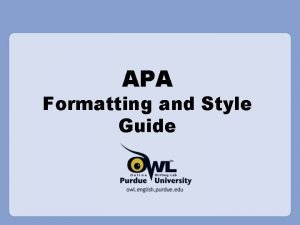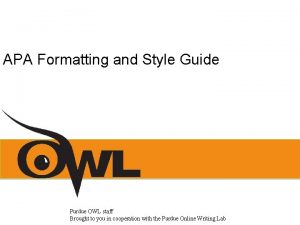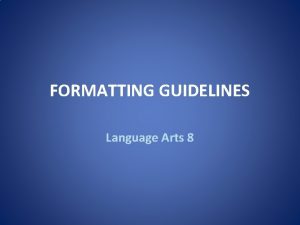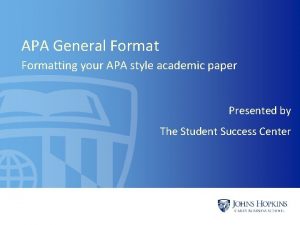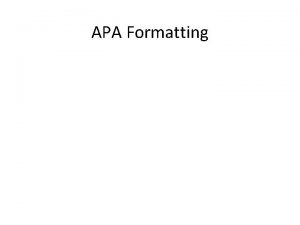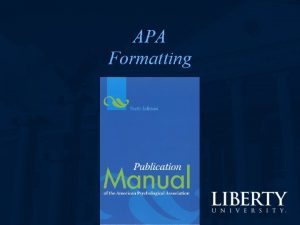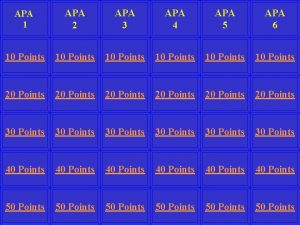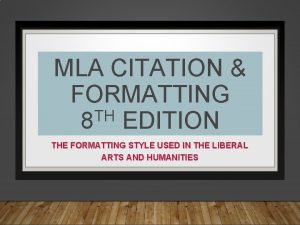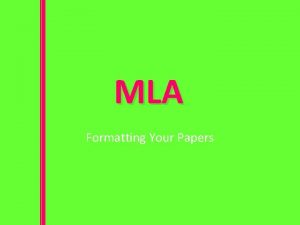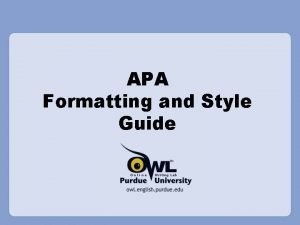APA sixth edition Formatting General APA Guidelines Your













- Slides: 13

APA ( sixth edition) Formatting.

General APA Guidelines Your essay should be typed and double-spaced on standard-sized paper (8. 5" x 11"), with 1" margins on all sides. You should use a clear font that is highly readable. APA recommends using 12 pt. Times New Roman font. Include a page header (also known as the "running head") at the top of every page. To create a page header/running head, insert page numbers flush right. Then type "TITLE OF YOUR PAPER" in the header flush left using all capital letters. The running head is a shortened version of your paper's title and cannot exceed 50 characters including spacing and punctuation.

Title Page Sample: http: //supp. apa. org/style/PM 6 E-Corrected-Sample. Papers. pdf (pg. 1) The title page should contain the title of the paper, the author's name, and the institutional affiliation. Include the page header (described above) flush left with the page number flush right at the top of the page. Please note that on the title page, your page header/running head should look like this: Running head: TITLE OF YOUR PAPER

Title Page Example

In- text citations Sample: http: //supp. apa. org/style/PM 6 E-Corrected-Sample-Papers. pdf ( pg. 2) Short quotations If you are directly quoting from a work, you will need to include the author, year of publication, and page number for the reference (preceded by "p. "). Introduce the quotation with a signal phrase that includes the author's last name followed by the date of publication in parentheses. According to Jones (1998), "Students often had difficulty using APA style, especially when it was their first time" (p. 199). Jones (1998) found "students often had difficulty using APA style" (p. 199); what implications does this have for teachers? If the author is not named in a signal phrase, place the author's last name, the year of publication, and the page number in parentheses after the quotation. She stated, "Students often had difficulty using APA style" (Jones, 1998, p. 199), but she did not offer an explanation as to why.

In-text citations Long quotations Place direct quotations that are 40 words or longer in a free-standing block of typewritten lines and omit quotation marks. Start the quotation on a new line, indented 1/2 inch from the left margin, i. e. , in the same place you would begin a new paragraph. Type the entire quotation on the new margin, and indent the first line of any subsequent paragraph within the quotation 1/2 inch from the new margin. Maintain double-spacing throughout. The parenthetical citation should come after the closing punctuation mark. Jones's (1998) study found the following: Students often had difficulty using APA style, especially when it was their first time citing sources. This difficulty could be attributed to the fact that many students failed to purchase a style manual or to ask their teacher for help. (p. 199)

In-text citations Summary or paraphrase If you are paraphrasing an idea from another work, you only have to make reference to the author and year of publication in your in-text reference, but APA guidelines encourage you to also provide the page number (although it is not required. )According to Jones (1998), APA style is a difficult citation format for first-time learners (Jones, 1998, p. 199).

APA Headings and Levels Sample: http: //supp. apa. org/style/PM 6 E-Corrected-Sample-Papers. pdf ( pg. 4) APA Style uses a unique headings system to separate and classify paper sections. Headings are used to help guide the reader through a document. The levels are organized by levels of subordination, and each section of the paper should start with the highest level of heading. There are 5 heading levels in APA. The 6 th edition of the APA manual revises and simplifies previous heading guidelines. Regardless of the number of levels, always use the headings in order, beginning with level 1.

APA Headings and Levels APA Headings Level 1 Format Centered, Boldface, Uppercase and Lowercase Headings 2 Left-aligned, Boldface, Uppercase and Lowercase Heading 3 Indented, boldface, lowercase heading with a period. 4 Indented, boldface, italicized, lowercase heading with a period. 5 Indented, italicized, lowercase heading with a period.

APA Headings and Levels Section headings receive level one format. Subsections receive level two format. Subsections of subsections receive level three format. For example: Method (Level 1) Site of Study (Level 2) Participant Population (Level 2) Teachers. (Level 3) Students. (Level 3)

Reference List Sample: http: //supp. apa. org/style/PM 6 E-Corrected-Sample-Papers. pdf ( pgs. 9 -11) Your reference list should appear at the end of your paper. It provides the information necessary for a reader to locate and retrieve any source you cite in the body of the paper. Each source you cite in the paper must appear in your reference list; likewise, each entry in the reference list must be cited in your text. Your references should begin on a new page separate from the text of the essay; label this page "References" centered at the top of the page (do NOT bold, underline, or use quotation marks for the title). All text should be double-spaced just like the rest of your essay.

Reference List Basic Rules All lines after the first line of each entry in your reference list should be indented onehalf inch from the left margin. This is called hanging indentation. Authors' names are inverted (last name first); give the last name and initials for all authors of a particular work for up to and including seven authors. If the work has more than seven authors, list the first six authors and then use ellipses after the sixth author's name. After the ellipses, list the last author's name of the work. Reference list entries should be alphabetized by the last name of the first author of each work. For multiple articles by the same author, or authors listed in the same order, list the entries in chronological order, from earliest to most recent.

Reference List Single Author Last name first, followed by author initials. Berndt, T. J. (2002). Friendship quality and social development. Current Directions in Psychological Science, 11, 7 -10. Two Authors List by their last names and initials. Use the ampersand instead of "and. " Wegener, D. T. , & Petty, R. E. (1994). Mood management across affective The hedonic contingency hypothesis. Journal of Personality and Social Psychology, 66, 1034 -1048. states: (See the department’s website for further guidance on APA formatting).
 Mmodation
Mmodation The sixth sick sheik's sixth sheep's sick lyrics
The sixth sick sheik's sixth sheep's sick lyrics Citation sample pdf
Citation sample pdf Biochemistry sixth edition 2007 w.h. freeman and company
Biochemistry sixth edition 2007 w.h. freeman and company Computer architecture a quantitative approach sixth edition
Computer architecture a quantitative approach sixth edition Automotive technology principles diagnosis and service
Automotive technology principles diagnosis and service Automotive technology sixth edition
Automotive technology sixth edition Computer architecture a quantitative approach 6th
Computer architecture a quantitative approach 6th Precalculus sixth edition
Precalculus sixth edition Rational people think at the margin
Rational people think at the margin Computer architecture a quantitative approach sixth edition
Computer architecture a quantitative approach sixth edition Apa header
Apa header Abstract page apa
Abstract page apa Purdue owl apa in text citation
Purdue owl apa in text citation












